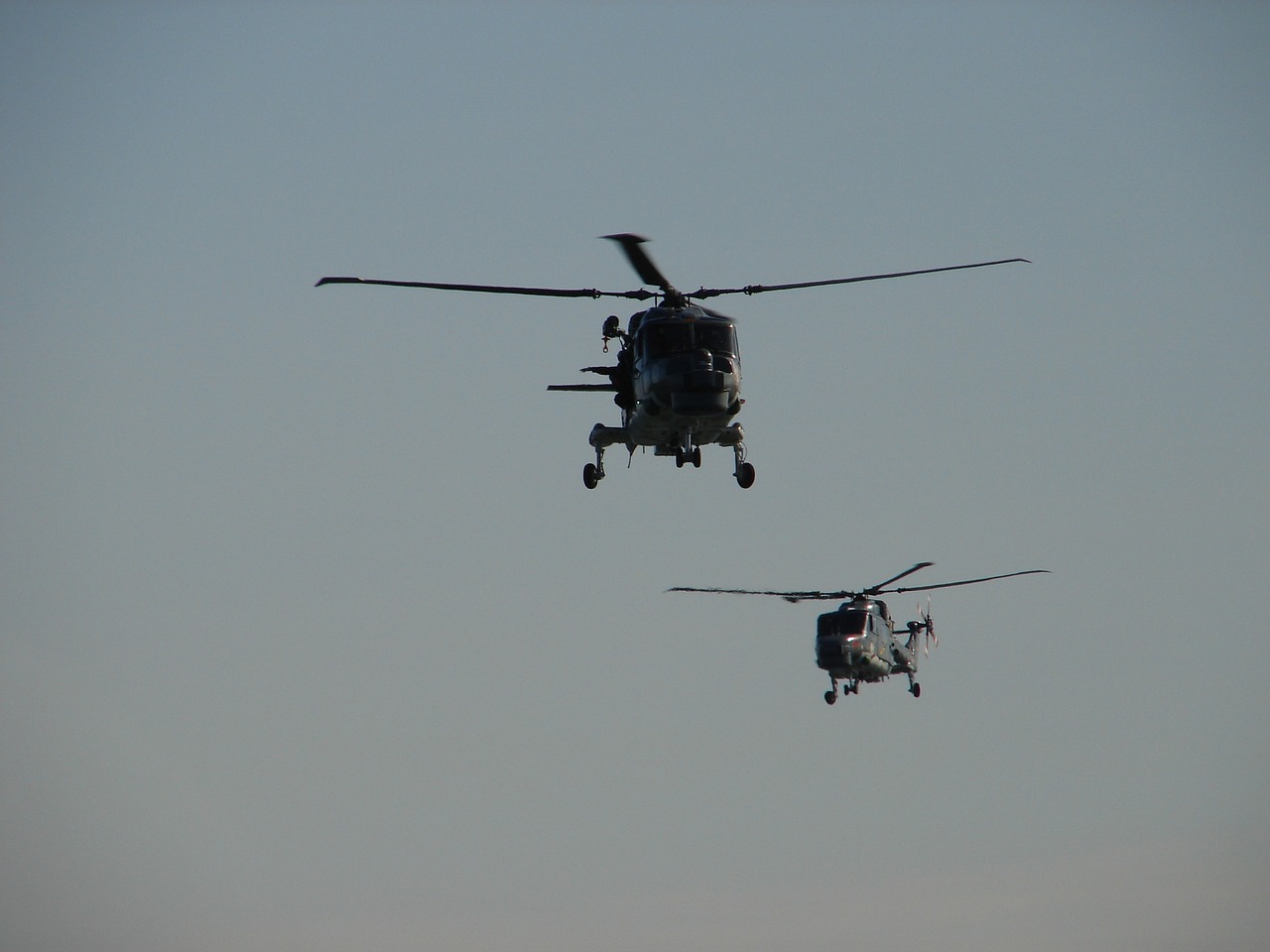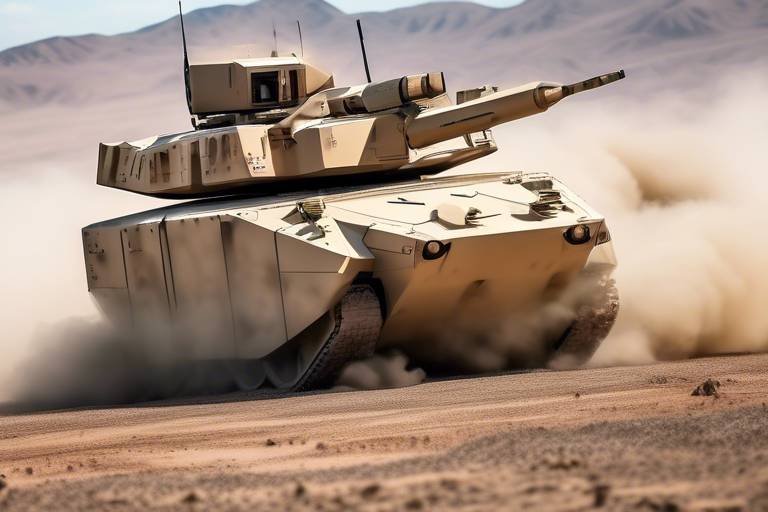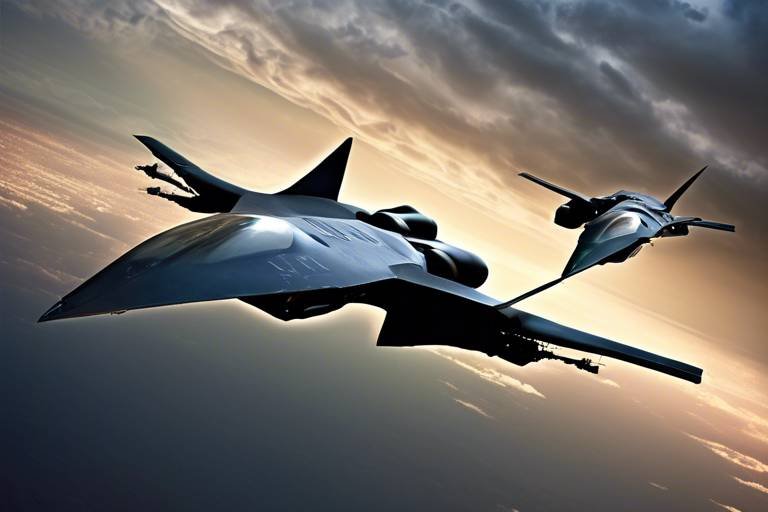How Advanced Defense Systems Support Regional Stability
In an increasingly complex world, the importance of advanced defense systems cannot be overstated. These systems are not just about military might; they play a crucial role in promoting security and stability across various regions. As nations invest in cutting-edge technologies, the landscape of international relations and military strategy is evolving rapidly. This article dives deep into how these advancements contribute to regional stability, examining their impact on diplomacy, conflict prevention, and military collaboration.
Regional stability serves as the bedrock for global peace and economic development. Think of it as the foundation of a house; without it, everything above is at risk. Factors contributing to stability include effective governance, economic cooperation, and social cohesion. Conversely, instability can lead to conflicts, humanitarian crises, and mass migrations, which can have ripple effects across the globe. For instance, when a region falls into chaos, neighboring countries often find themselves grappling with the fallout, whether it's an influx of refugees or increased security threats.
Recent technological innovations have revolutionized defense systems, enhancing military capabilities in ways previously thought impossible. From artificial intelligence to hypersonic weapons, these advancements are not merely enhancements but game-changers. They provide nations with tools to deter threats, respond to crises, and engage in strategic partnerships. The implications for regional security are profound, as countries equipped with advanced systems can better protect their interests and contribute to collective defense initiatives.
Among the most critical components of modern defense are missile defense systems. These systems are essential for deterring potential threats and ensuring the safety of nations. Imagine a shield that not only protects but also reassures the populace of a nation. By neutralizing incoming threats, these systems foster a sense of security that is vital for regional stability. Countries can focus on development and diplomacy instead of being preoccupied with existential threats.
Interception technologies are at the forefront of missile defense systems. They are designed to identify, track, and neutralize incoming missiles before they reach their targets. The mechanics behind these technologies involve sophisticated radar systems and advanced algorithms that can predict trajectories and respond in real-time. The effectiveness of these systems has been demonstrated in various scenarios, showcasing their ability to protect not just military installations but also civilian populations. For instance, the successful interception of missiles during conflicts has proven invaluable in maintaining peace and order.
The integration of missile defense systems with allied forces enhances collective security. This collaboration is akin to a team of superheroes joining forces to combat a common enemy. When nations share their technological advancements and coordinate their defense strategies, they create a formidable barrier against potential aggressors. Joint exercises and shared intelligence further strengthen these alliances, ensuring that all parties are prepared to respond swiftly and effectively to threats.
In today's digital age, cyber defense strategies are just as crucial as traditional military capabilities. The rise of cyber threats poses a significant risk to national security and regional stability. Countries must invest in robust cybersecurity measures to protect their critical infrastructure and sensitive information. A breach in cybersecurity can lead to chaos, affecting everything from financial systems to military operations. By prioritizing cybersecurity, nations can safeguard their interests and maintain stability in an increasingly interconnected world.
Advanced defense systems have a profound impact on international relations. They can either foster cooperation among nations or exacerbate tensions, depending on how they are perceived and utilized. For instance, nations that invest in advanced defense technologies often find themselves in a position of strength, which can lead to a more assertive foreign policy. This dynamic can create a sense of insecurity among neighboring countries, potentially igniting an arms race.
Deterrence strategies frequently rely on advanced defense capabilities. It's like a game of chess where each move must be calculated carefully. Countries must balance their military preparedness with diplomatic efforts to promote peace. A show of strength can deter aggression, but it must be accompanied by open channels of communication to avoid misunderstandings that could lead to conflict.
The development of advanced defense systems can trigger arms races, as nations strive to keep pace with one another. This dynamic can have significant implications for both regional and global stability. An arms race can drain national resources and divert attention from pressing issues like poverty and climate change. Therefore, it's essential for countries to engage in dialogue and consider arms control agreements to mitigate these risks.
Analyzing specific case studies provides valuable insights into how advanced defense systems have successfully supported stability. For example, the cooperation between NATO allies in developing missile defense systems has not only enhanced their collective security but has also sent a strong message to potential adversaries. Similarly, countries in the Asia-Pacific region are increasingly collaborating on cybersecurity initiatives to counter digital threats, showcasing the importance of technology in maintaining peace.
- What are advanced defense systems? Advanced defense systems refer to modern military technologies designed to enhance national security, including missile defense systems and cyber defense strategies.
- How do these systems promote regional stability? By deterring threats and enhancing military collaboration, advanced defense systems create a secure environment that fosters peace and development.
- Can advanced defense systems lead to an arms race? Yes, the development of sophisticated military technologies can trigger arms races, which may destabilize regions if not managed through diplomatic efforts.

The Importance of Regional Stability
This article explores the role of advanced defense systems in promoting security and stability in various regions, examining their impact on international relations, military strategy, and conflict prevention.
Regional stability is not just a buzzword; it’s a fundamental pillar upon which global peace and economic development rest. Think of it like a well-tuned orchestra: when all the instruments play in harmony, the music is beautiful, but if one instrument is out of tune, it can ruin the entire performance. In the same way, stability in one region can have a ripple effect, fostering peace and prosperity in surrounding areas. Factors contributing to regional stability include effective governance, economic interdependence, and social cohesion, while instability can lead to chaos, conflict, and humanitarian crises.
When we talk about stability, we often think about security. A stable region is less likely to experience conflicts that can escalate into larger wars, which can have devastating effects not just locally, but globally. For instance, consider the Middle East; the instability there has led to numerous conflicts, affecting international oil prices and leading to refugee crises that impact countries far beyond its borders. On the other hand, regions like Scandinavia, known for their stability and cooperation, enjoy not only peace but also robust economic growth and high standards of living.
Moreover, regional stability creates an environment conducive to foreign investment. Investors are more likely to put their money into areas where the risk of conflict is low. This influx of capital can lead to job creation, infrastructure development, and overall economic improvement. For example, countries in Southeast Asia have seen significant economic growth due to their stable political environments and cooperative trade agreements. Conversely, regions plagued by instability often find themselves trapped in cycles of poverty and violence.
To summarize, the importance of regional stability cannot be overstated. It is essential for:
- Maintaining global peace
- Encouraging economic development
- Preventing conflicts
- Facilitating international cooperation
In conclusion, understanding the dynamics of regional stability is crucial for policymakers, military strategists, and global citizens alike. The stakes are high, and the consequences of instability can be felt far and wide. By investing in measures that promote stability, we can help create a more peaceful and prosperous world for everyone.
- What is regional stability? Regional stability refers to the absence of conflict and the presence of cooperative relationships among countries in a specific area.
- Why is regional stability important? It is vital for global peace, economic development, and the prevention of conflicts that can escalate into larger wars.
- How do advanced defense systems contribute to regional stability? They deter potential threats, enhance military capabilities, and facilitate cooperation among allied nations.

Technological Advancements in Defense Systems
The landscape of defense is rapidly evolving, thanks to technological advancements that are reshaping military capabilities across the globe. These innovations are not just about enhancing firepower; they are fundamentally changing how nations protect their interests and maintain regional stability. From advanced missile defense systems to sophisticated cyber defense strategies, the integration of cutting-edge technology into defense frameworks has become a game changer in international relations.
One of the most significant breakthroughs in recent years has been the development of missile defense systems. These systems are designed to intercept and neutralize incoming threats, thereby providing a robust shield against potential aggressors. Imagine a fortress equipped with the latest technology, capable of detecting and deflecting arrows before they can reach its walls. This analogy perfectly encapsulates the role of missile defense in modern warfare. Countries investing in these systems are not only enhancing their own security but are also contributing to a collective sense of safety within their regions.
Missile defense systems serve as a deterrent against hostile actions, creating a security umbrella that reassures allied nations. For instance, nations like the United States and its partners have deployed advanced systems such as the Terminal High Altitude Area Defense (THAAD) and the Aegis Ballistic Missile Defense. These systems utilize state-of-the-art interception technologies that are crucial for neutralizing threats from long-range missiles. The deployment of such systems not only protects the host nation but also enhances the overall security architecture of the region.
At the heart of missile defense systems are interception technologies that have dramatically improved in precision and speed. These technologies utilize a combination of radar, sensors, and advanced algorithms to track and intercept incoming threats. The mechanics of these systems can be likened to a high-stakes game of chess, where each move is calculated in real-time to outsmart the opponent. For example, the integration of kinetic interceptors and hit-to-kill technology allows for a direct collision with the incoming missile, effectively neutralizing it before it can reach its target. This level of sophistication not only enhances the effectiveness of defense systems but also instills confidence among allied nations regarding their collective security.
Moreover, the integration of missile defense systems with allied forces has become a cornerstone of modern military strategy. Countries are increasingly recognizing that collective security is paramount in today’s geopolitical climate. Collaborative efforts, such as joint exercises and shared technologies, are essential in enhancing the operational readiness of allied nations. This integration can be visualized as a tightly knit web of defense, where each strand reinforces the others, creating a resilient structure capable of withstanding external threats. The success of such collaborative defense initiatives can be seen in various regions, where nations pool their resources and expertise to create a unified front against potential aggressors.
In addition to missile defense, the rise of cyber defense strategies is another critical aspect of technological advancements in defense systems. As the digital landscape expands, so do the threats posed by cyberattacks. Nations must now fortify their digital borders just as they do their physical ones. Cyber defense strategies involve a multifaceted approach, including advanced encryption, threat detection, and rapid response capabilities. Think of it as building a digital fortress that not only protects sensitive information but also ensures the integrity of national security. Countries that prioritize cyber defense are better equipped to handle the complexities of modern warfare, where the battlefield extends beyond traditional borders.
In conclusion, the advancements in defense technologies are not merely enhancements; they are essential components in the quest for regional stability. By investing in missile defense systems and cyber strategies, nations are not just safeguarding themselves but are also contributing to a more secure global environment. As we move forward, the interplay between technology and defense will continue to shape the dynamics of international relations, making it imperative for countries to stay ahead of the curve.
- What are missile defense systems? Missile defense systems are technologies designed to detect, track, and intercept incoming missiles, providing protection against potential threats.
- How do interception technologies work? Interception technologies utilize radar, sensors, and advanced algorithms to identify and neutralize incoming threats, often through kinetic interceptors.
- Why is regional stability important? Regional stability is crucial for global peace, economic development, and the prevention of conflicts between nations.
- What role does cyber defense play in national security? Cyber defense protects against digital threats, safeguarding sensitive information and maintaining the integrity of national security in an increasingly digital world.

Missile Defense Systems
In today's world, the threat of missile attacks looms larger than ever, making a pivotal component of national security strategies. These systems are designed not only to intercept and neutralize incoming missiles but also to serve as a deterrent against potential aggressors. Imagine a fortress equipped with high-tech shields; that’s essentially what these advanced systems represent for nations around the globe. By providing a robust layer of defense, they help maintain regional stability and foster a sense of security among allied nations.
Missile defense systems operate on several levels, utilizing a combination of radar technology, interceptor missiles, and advanced software to detect and respond to threats. The effectiveness of these systems hinges on their ability to integrate seamlessly with existing military infrastructure and protocols. For instance, when a missile is launched, the system quickly assesses the threat, calculates its trajectory, and deploys interceptors to neutralize it before it can reach its target. This rapid response mechanism is crucial for ensuring that nations can defend themselves against surprise attacks, thereby enhancing overall regional security.
Moreover, the deployment of missile defense systems often leads to increased collaboration among allied nations, creating a network of shared intelligence and resources. This integration is not just about technology; it’s about building trust and enhancing collective security. Countries that invest in these systems frequently engage in joint training exercises, share data on missile threats, and develop coordinated response strategies. Such cooperation can significantly reduce the likelihood of conflict, as nations demonstrate their commitment to mutual defense and stability.
However, the presence of missile defense systems can also create a paradox. While they are intended to promote peace and security, they can sometimes lead to heightened tensions, particularly among rival nations. This is primarily due to the deterrence effect—the idea that one nation's defensive capabilities can provoke another to enhance its offensive capabilities, leading to an arms race. To illustrate this, consider the following table that outlines the balance between missile defense systems and regional tensions:
| Region | Missile Defense Deployment | Regional Tensions |
|---|---|---|
| North East Asia | High (e.g., THAAD in South Korea) | Increased tensions with North Korea |
| Middle East | Moderate (e.g., Iron Dome in Israel) | Ongoing conflicts with neighboring nations |
| Europe | Low (e.g., NATO missile defense) | Varied, but generally stable |
As we can see, the implications of missile defense systems are complex and multifaceted. While they are essential for safeguarding nations, the potential for escalating tensions cannot be overlooked. The challenge lies in finding a balance between maintaining a robust defense posture and engaging in diplomatic efforts to mitigate conflict. Ultimately, the effectiveness of missile defense systems in promoting regional stability will depend on the broader context of international relations and the willingness of nations to cooperate in the face of shared threats.

Interception Technologies
When we think about , it's like peering into the future of defense strategies. These technologies are not just a shield; they're the backbone of modern military capabilities. Imagine a scenario where a nation is under threat from incoming missiles. What if there were systems designed to detect, track, and neutralize these threats before they can cause any harm? That's the magic of interception technologies!
At the heart of these systems lies a combination of sophisticated radar, advanced algorithms, and cutting-edge projectiles. For instance, many interception systems utilize phased array radar to provide real-time tracking of threats. This technology allows for rapid scanning of the sky, ensuring that any incoming missile is detected almost instantly. Once a threat is identified, the system calculates its trajectory, enabling a targeted response.
But how effective are these technologies in real-world scenarios? Let's take a closer look at some of the most notable interception technologies:
| Technology | Description | Effectiveness |
|---|---|---|
| Patriot Missile System | A surface-to-air missile system that intercepts tactical ballistic missiles. | Proven success in various conflicts, with a high interception rate. |
| THAAD (Terminal High Altitude Area Defense) | A system designed to intercept short, medium, and intermediate-range ballistic missiles. | Highly effective in testing scenarios, providing a multi-layer defense. |
| Aegis Ballistic Missile Defense | Naval defense system that uses powerful radars to track and intercept missiles. | Successful interceptions during both tests and real-world engagements. |
These systems are not merely standalone; they often operate in conjunction with one another, creating a multi-layered defense strategy that enhances a nation's security. The integration of interception technologies with intelligence gathering and surveillance systems ensures that threats are neutralized before they can escalate into a full-blown crisis. This proactive approach not only protects nations but also contributes significantly to regional stability.
Furthermore, the effectiveness of these technologies is not just about their operational capabilities; it's also about the psychological impact they have on potential aggressors. When nations have robust interception systems in place, it sends a clear message: aggression will not be tolerated. This deterrent effect plays a crucial role in maintaining peace and stability in volatile regions.
In conclusion, interception technologies are a critical component of modern defense strategies. They not only safeguard nations from immediate threats but also foster a sense of security that is vital for regional stability. As technology continues to evolve, we can expect these systems to become even more sophisticated, further enhancing our ability to prevent conflict and promote peace.
- What are interception technologies? These are advanced systems designed to detect and neutralize incoming threats, such as missiles.
- How do these technologies contribute to regional stability? By providing a deterrent against aggression, they help maintain peace and security.
- Can interception technologies work in conjunction with other defense systems? Yes, they often operate alongside other military capabilities for a comprehensive defense strategy.

Integration with Allied Forces
The integration of advanced defense systems with allied forces is not just a tactical necessity; it is a strategic imperative that enhances collective security across regions. Imagine a well-coordinated orchestra, where each instrument plays its part in harmony, producing a symphony of defense capabilities that protect nations from emerging threats. This collaboration is crucial, especially in an era where global security challenges are increasingly complex and interconnected.
When nations pool their resources and expertise, they create a robust defense network that can effectively respond to various threats. This integration is often facilitated through joint exercises, shared intelligence, and interoperable systems that allow different military forces to work seamlessly together. For instance, countries like the United States, NATO allies, and partners in the Asia-Pacific region have developed frameworks that enable them to integrate their missile defense systems. This not only improves their defensive posture but also sends a strong message to potential aggressors about their collective resolve.
Moreover, the development of communication technologies plays a pivotal role in this integration. Advanced communication systems ensure that allied forces can share real-time data and coordinate responses quickly, which is vital during crises. For example, during joint military drills, the ability to communicate effectively can mean the difference between thwarting an attack and facing dire consequences. This synergy is further enhanced by:
- Joint Training Programs: Regular training exercises help forces understand each other's capabilities and limitations.
- Shared Intelligence: Collaborative intelligence-gathering efforts ensure that all parties are aware of potential threats.
- Interoperable Technologies: Systems designed to work together streamline operations and increase efficiency.
Additionally, the integration of missile defense systems among allied nations fosters a sense of trust and solidarity, which is essential for long-term regional stability. Countries that work together in defense are more likely to engage in diplomatic dialogues, reducing the chances of misunderstandings that could lead to conflict. This collaborative approach also serves as a deterrent; adversaries are less likely to engage in aggressive actions when they recognize that their opponents are united and prepared.
In conclusion, the integration of advanced defense systems with allied forces is a cornerstone of modern military strategy. It not only enhances the capabilities of individual nations but also fortifies regional security as a whole. As threats continue to evolve, the importance of this integration will only grow, making it essential for nations to remain committed to working together in the face of uncertainty.
Q1: Why is integration with allied forces important?
A1: Integration enhances collective security, allowing nations to respond effectively to threats through shared resources, intelligence, and coordinated military efforts.
Q2: How do joint training programs benefit allied forces?
A2: Joint training programs improve understanding of each other's capabilities, foster trust, and ensure that forces can operate together seamlessly during crises.
Q3: What role does technology play in the integration of defense systems?
A3: Advanced communication and interoperable technologies are crucial for facilitating real-time data sharing and coordination among allied forces, enhancing overall operational effectiveness.

Cyber Defense Strategies
In today's interconnected world, where information flows as freely as water, have emerged as a cornerstone of national security and regional stability. Imagine your nation as a fortress; while the walls are essential, what about the gates that allow information in and out? These gates, if not properly secured, can become vulnerabilities that adversaries exploit. Cyber defense strategies are the sentinels at these gates, ensuring that malicious actors cannot breach the fortress and compromise its integrity.
The significance of cybersecurity cannot be overstated, especially as we witness an increase in cyber threats from state and non-state actors alike. From ransomware attacks that can cripple vital infrastructure to espionage that seeks to steal sensitive information, the implications of cyber vulnerabilities are profound. Countries are recognizing that cybersecurity is not just a technical issue but a fundamental aspect of their national defense and regional stability. The development of robust cyber defense strategies is akin to building a high-tech security system that not only detects intrusions but also actively prevents them.
One of the key components of effective cyber defense strategies is the implementation of multi-layered security protocols. These protocols can include firewalls, intrusion detection systems, and regular software updates, all working in tandem to create a comprehensive defense network. Think of it as a series of defensive layers that protect the most critical assets of a nation. For example, a well-structured incident response plan can be the difference between a minor breach and a full-blown crisis. When these strategies are executed effectively, they enhance resilience and deter potential attackers.
Moreover, international cooperation plays a pivotal role in strengthening cyber defenses. Countries are increasingly engaging in information sharing and collaborative exercises to enhance their collective cybersecurity posture. This cooperation can take various forms, such as joint training programs, intelligence sharing agreements, and collaborative cybersecurity initiatives. By working together, nations can create a formidable front against cyber threats, ensuring that no single nation fights this battle alone. For instance, NATO has established a Cyber Defense Centre of Excellence that focuses on improving the cyber capabilities of its member states.
To illustrate the impact of these strategies, let’s take a look at a few key statistics:
| Statistic | Impact |
|---|---|
| Over 60% of businesses | have experienced a cyber attack in the past year. |
| Countries with strong cyber defense strategies | report a 30% reduction in successful cyber attacks. |
| Collaboration among nations | has led to a 40% increase in threat detection capabilities. |
As the landscape of warfare evolves, so too must our understanding of what constitutes a threat. Cyber defense strategies are not merely reactive; they are proactive measures that allow nations to stay one step ahead of potential adversaries. By investing in cutting-edge technologies and fostering a culture of cybersecurity awareness, nations can protect their interests and maintain regional stability. In essence, a strong cyber defense is like a well-trained army, ready to defend against any attack, ensuring that peace prevails in an increasingly chaotic digital world.
- What are cyber defense strategies? Cyber defense strategies encompass a range of measures and protocols designed to protect national and regional interests from cyber threats.
- Why are cyber defense strategies important for regional stability? They help prevent cyber attacks that can destabilize economies, disrupt critical infrastructure, and create tensions between nations.
- How do countries collaborate on cybersecurity? Through information sharing, joint training exercises, and international agreements, countries can enhance their collective cyber defense capabilities.
- What role does technology play in cyber defense? Advanced technologies such as artificial intelligence and machine learning are increasingly used to detect and respond to cyber threats in real-time.

Impact on International Relations
Advanced defense systems have a profound impact on international relations, shaping the dynamics between nations in ways that are both subtle and overt. At the heart of this influence lies the delicate balance of power; countries equipped with cutting-edge military technologies often find themselves in a position to negotiate from a place of strength. This can lead to enhanced security cooperation among allies, as nations seek to bolster their defenses collectively against common threats. However, it can also create an atmosphere of suspicion and competition, where nations feel compelled to enhance their own military capabilities in response.
One of the most intriguing aspects of this phenomenon is the concept of deterrence. When a nation possesses advanced defense systems, it sends a clear message to potential adversaries: any aggressive action may be met with a formidable response. This principle of deterrence can lead to a decrease in military confrontations, as countries weigh the costs of conflict against the potential benefits. However, this is a double-edged sword; the very presence of advanced military technology can also escalate tensions, leading to an arms race as neighboring countries scramble to keep up.
Moreover, the integration of advanced defense systems into military strategy can foster new forms of diplomacy. Nations may engage in arms control negotiations or treaties aimed at limiting the proliferation of certain technologies. These diplomatic efforts can be crucial in maintaining regional stability, as they provide a framework for communication and conflict resolution. For instance, countries might enter into agreements that restrict the development of specific missile defense systems, thereby reducing the likelihood of an arms race and promoting a more stable international environment.
However, it’s essential to recognize that the impact of advanced defense systems on international relations is not uniform across the globe. Different regions experience these dynamics in varied ways, influenced by historical contexts, existing alliances, and geopolitical interests. For example, in areas where longstanding rivalries exist, such as in the Middle East or South Asia, the introduction of advanced military technologies can exacerbate existing tensions, leading to a cycle of escalation that undermines efforts for peace.
To illustrate the complexities involved, consider the following table that summarizes the dual nature of advanced defense systems in international relations:
| Positive Impacts | Negative Impacts |
|---|---|
| Enhanced security cooperation among allies | Increased suspicion and competition |
| Deterrence of aggressive actions | Potential for arms races |
| Opportunities for diplomatic negotiations | Escalation of regional tensions |
In conclusion, the impact of advanced defense systems on international relations is multifaceted, presenting both opportunities for enhanced security and risks of increased conflict. As nations navigate this complex landscape, the challenge lies in leveraging these technologies to promote stability while avoiding the pitfalls of escalation. To achieve lasting peace, a careful balance must be struck between military preparedness and diplomatic engagement, ensuring that advanced defense systems serve as a tool for stability rather than a catalyst for conflict.
- How do advanced defense systems contribute to regional stability?
They enhance deterrence capabilities, promote security cooperation among allies, and can lead to diplomatic negotiations aimed at conflict resolution.
- What are the risks associated with advanced defense systems?
The introduction of these systems can trigger arms races, escalate tensions, and create an environment of suspicion among nations.
- Can advanced defense systems lead to peace?
Yes, if managed properly, they can deter aggression and provide a basis for diplomatic engagement, ultimately contributing to regional stability.

Deterrence and Diplomacy
When we think about the balance between deterrence and diplomacy, it's like walking a tightrope. On one side, you have the need for military readiness to deter potential aggressors, and on the other, the necessity of engaging in diplomatic efforts to maintain peace and cooperation. Advanced defense systems play a pivotal role in this dynamic, acting as both a shield and a bridge in international relations. Countries equipped with sophisticated military technologies can project power, which often leads to a sense of security and stability. However, this power projection can also stir the pot of tension, making diplomacy all the more crucial.
For instance, consider the role of missile defense systems. These systems are not just about intercepting incoming threats; they also serve as a signal to both allies and adversaries. When a nation invests heavily in advanced missile defense, it sends a clear message: “We are prepared to defend ourselves.” This preparedness can deter hostile actions, as potential aggressors might think twice before launching an attack. However, this same display of military capability can provoke fear and suspicion among neighboring countries, leading to an arms race. Thus, while deterrence can prevent conflicts, it can also escalate tensions if not balanced with effective diplomatic strategies.
Moreover, diplomacy is essential in ensuring that deterrence does not lead to misunderstanding or miscalculation. Engaging in dialogue, participating in international treaties, and building alliances are all crucial components of a comprehensive security strategy. For example, the North Atlantic Treaty Organization (NATO) exemplifies how collective defense can be paired with diplomatic efforts to maintain regional stability. Through regular communication and joint exercises, NATO members not only enhance their military readiness but also foster trust and cooperation, thus reducing the likelihood of conflict.
In the real world, the interplay between deterrence and diplomacy can be seen in various regions. Countries in the Asia-Pacific, for instance, are navigating a complex security environment where advanced defense systems are becoming increasingly prevalent. The United States' deployment of missile defense systems in South Korea was intended to deter North Korean aggression. However, it also sparked diplomatic tensions with China, which viewed these systems as a threat to its own security. This scenario illustrates how advanced defense technologies can create a cycle of deterrence and diplomatic negotiations, where nations must continually reassess their strategies to ensure stability.
Ultimately, the challenge lies in achieving a balance where deterrence effectively prevents conflict while diplomacy paves the way for peaceful resolutions. Policymakers must be astute, recognizing that military might should complement diplomatic efforts, not overshadow them. As nations continue to evolve their defense strategies, the dance between deterrence and diplomacy will remain a critical factor in promoting regional stability.
- What is deterrence in international relations? Deterrence refers to the strategy of preventing an adversary from taking an undesirable action, typically through the threat of military retaliation.
- How do advanced defense systems influence diplomacy? Advanced defense systems can enhance a nation's security, making it a more formidable player on the global stage, which can either foster cooperation or exacerbate tensions.
- Can diplomacy exist alongside military preparedness? Absolutely! Effective diplomacy is essential for managing the risks that come with military preparedness, ensuring that nations can communicate and resolve conflicts without resorting to violence.
- What role do alliances play in deterrence? Alliances can strengthen deterrence by pooling resources and capabilities, thereby increasing the collective security of member nations and discouraging potential aggressors.

Arms Race Dynamics
The development of advanced defense systems can often set off a chain reaction, igniting what is commonly referred to as an arms race. This phenomenon occurs when one nation enhances its military capabilities, prompting neighboring countries to respond in kind to maintain their own security. It's a bit like a game of chess; when one player makes a bold move, the others must reconsider their strategies to keep up. This dynamic creates a tension-filled atmosphere, where the stakes are incredibly high, and the potential for conflict looms larger than ever.
Arms races can manifest in various forms, from nuclear proliferation to advancements in conventional military technology. For instance, when a country invests heavily in missile defense systems, its adversaries may feel compelled to develop countermeasures or even their own advanced systems. This cycle can lead to a continuous escalation of military spending, diverting resources away from critical areas like education and healthcare, which could otherwise foster long-term stability and prosperity.
To better understand the implications of arms race dynamics, consider the following factors:
- Security Dilemma: Nations may perceive each other's military enhancements as threats, leading to a cycle of distrust and escalation.
- Economic Impact: Increased military spending can strain national budgets, affecting social programs and economic growth.
- Global Stability: Arms races can destabilize entire regions, making diplomatic resolutions more challenging and increasing the risk of conflict.
Furthermore, arms races are not just a local issue; they can have global repercussions. For example, the Cold War era saw a significant arms race between the United States and the Soviet Union, which not only affected their bilateral relations but also had a profound impact on global geopolitics. Countries around the world were drawn into the conflict, either by aligning with one of the superpowers or by trying to develop their own military capabilities in response to the perceived threat.
The cycle of arms races can create a vicious cycle that is hard to break. As nations invest in new technologies, they may inadvertently provoke their neighbors, leading to a series of defensive measures that escalate tensions further. This scenario can create a precarious balance, where one miscalculation or misunderstanding could lead to a larger conflict. The importance of diplomacy and communication cannot be overstated in these situations; without open lines of dialogue, nations may resort to military posturing that only heightens the risk of confrontation.
In conclusion, the dynamics of arms races highlight the delicate balance between security and stability. While advanced defense systems can enhance a nation's security, they can also trigger a cycle of competition that undermines regional and global peace. It is essential for nations to engage in cooperative security measures and diplomatic efforts to mitigate the risks associated with these dynamics. Only through collaboration and mutual understanding can we hope to break the cycle of arms races and foster a more stable world.
- What is an arms race? An arms race is a competition between countries to develop and accumulate weapons and military technology, often in response to perceived threats from each other.
- How do arms races affect global stability? Arms races can lead to increased tensions between nations, making diplomatic resolutions more difficult and raising the risk of conflict.
- What can be done to prevent arms races? Engaging in diplomatic dialogue, establishing arms control agreements, and promoting cooperative security measures can help mitigate the risks of arms races.

Case Studies of Regional Stability
When we talk about regional stability, it's essential to look at real-world examples that illustrate how advanced defense systems can make a significant difference. One of the most compelling case studies is the situation in Eastern Europe, particularly regarding NATO's deployment of missile defense systems in Poland and Romania. These systems were established to counter potential threats from the east, specifically from nations like Russia. The presence of these defense systems has not only enhanced the military readiness of NATO allies but also served as a deterrent against aggressive maneuvers, fostering a sense of security among member nations.
Another notable example can be found in the Asia-Pacific region. Countries like Japan and South Korea have invested heavily in advanced missile defense technologies, primarily due to the ongoing threats from North Korea. The deployment of systems such as the THAAD (Terminal High Altitude Area Defense) and Aegis Ballistic Missile Defense has significantly increased their defensive capabilities. This investment has not only strengthened their national security but also contributed to a more stable regional environment. The collaboration between the United States and these nations in defense exercises further solidifies alliances and promotes a collective security framework.
In the Middle East, the case of Israel and its Iron Dome defense system showcases how advanced technology can protect a nation from ongoing threats. The Iron Dome has intercepted thousands of incoming projectiles, significantly reducing the impact of rocket attacks on civilian areas. This capability has not only saved lives but has also allowed for a more stable domestic environment, enabling the government to focus on diplomatic efforts rather than purely military responses. The success of the Iron Dome has also led to discussions about similar systems in neighboring countries, promoting a dialogue on regional security.
Moreover, the integration of cyber defense strategies in various nations serves as another critical aspect of maintaining regional stability. For instance, the European Union has initiated several programs aimed at enhancing cybersecurity among member states. These initiatives not only protect individual countries from cyber threats but also create a more resilient collective defense posture. By sharing intelligence and resources, nations can better prepare for and respond to digital threats, which have become increasingly prevalent in today's interconnected world.
To summarize, these case studies highlight the multifaceted role that advanced defense systems play in promoting regional stability. By deterring threats, enhancing military capabilities, and fostering international cooperation, these systems create an environment where peace can flourish. The ongoing investment in defense technology is not merely about military might; it is about creating a foundation for long-term security and stability in a rapidly changing global landscape.
- What are advanced defense systems?
Advanced defense systems refer to modern military technologies designed to protect nations from various threats, including missile attacks and cyber warfare. - How do missile defense systems contribute to regional stability?
Missile defense systems act as a deterrent against potential aggressors, thereby fostering a more secure environment for nations within a region. - Can advanced defense systems lead to arms races?
Yes, the development of advanced defense capabilities can sometimes trigger arms races as nations seek to maintain a balance of power. - What role does cybersecurity play in regional stability?
Cybersecurity is crucial for protecting national interests and ensuring that nations can effectively respond to digital threats, contributing to overall stability.
Frequently Asked Questions
- What is the role of advanced defense systems in regional stability?
Advanced defense systems play a crucial role in maintaining regional stability by deterring potential threats and enhancing the military capabilities of nations. They help to create a secure environment, which is essential for economic development and international relations.
- How do missile defense systems contribute to security?
Missile defense systems are designed to intercept and neutralize incoming threats, such as ballistic missiles. By providing a protective shield, these systems not only safeguard nations but also act as a deterrent against adversaries, thereby promoting peace and stability in the region.
- What are interception technologies, and why are they important?
Interception technologies are advanced mechanisms that detect and destroy incoming missiles before they reach their targets. These technologies are vital for national security as they enhance the effectiveness of defense systems and reduce the risk of catastrophic attacks, thereby maintaining regional stability.
- How does cyber defense impact national security?
Cyber defense strategies are essential in protecting a nation’s critical infrastructure from digital threats. With the increasing reliance on technology, robust cybersecurity measures help to prevent cyberattacks that could destabilize a region, ensuring the safety and security of its citizens.
- Can advanced defense systems lead to arms races?
Yes, the development and deployment of advanced defense systems can trigger arms races among nations. As countries seek to enhance their military capabilities, this can lead to increased tensions and competition, which may undermine regional and global stability.
- How do advanced defense systems affect international relations?
Advanced defense systems can influence international relations in both positive and negative ways. They may foster cooperation among allies through joint defense initiatives, but they can also exacerbate tensions between rival nations, leading to a complex interplay of diplomacy and deterrence.
- What are some examples of successful case studies in regional stability?
Various case studies demonstrate how advanced defense systems have supported regional stability. For example, collaborative missile defense initiatives between NATO allies have proven effective in deterring threats and fostering a sense of security among member nations.



















